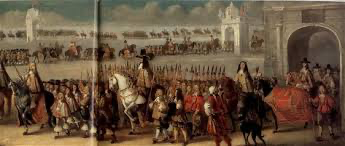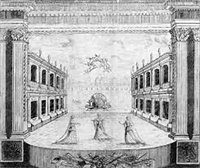The English Restoration
The Restoration was technically the resumption of the monarch in England but also a cultural reawakening of sorts, a time of cultural reawakening and social change. 
The monarch was King Charles II, whose father, King Charles I had preferred Personal Rule to dealing with Parliament; the resulting loggerheads between the two sides of that political dispute turned violent and resulted in the English Civil Wars and, eventually, the execution of the king. Taking the reins of government after the fighting stopped was Oliver Cromwell, who had proved to be a talented cavalry commander for the Parliamentarian forces during the Civil Wars. He was named Lord Protector and ruled with increasingly dictatorial powers for a few years. He was succeeded by his son, Richard, who proved to be neither the military strategies nor the political statesman that his father was. Richard had support of neither Parliament or the army and so, after a few months, resigned in early 1659. The following year, a group of nobles called Charles back to England, offering him the crown. Charles returned to London on May 29, 1660, which was his 30th birthday. This day was made a public holiday, a day known as Oak Apple Day. He had agreed to a number of terms set forth by the political leaders who had invited him to return. In the Declaration of Breda, Charles agreed to:

In return, the political leaders of the time declared that Charles's reign dated to the day after his father, King Charles I, was executed (meaning that the Interregnum, as the reign of the two Cromwells was known, was technically illegitimate). Charles II was crowned just less than a year later, on April 23, 1661, at Westminster Abbey. Less than a month later, Parliament convened. Consisting of a large majority of Royalists, it was known as the Cavalier Parliament. It was in session for nearly 18 years. For the most part, the post-Interregnum policies of the government were non-violent. An exception was the leaders of the movement that resulted in the trial and execution of the king. A majority of those leaders were still around, and many of them were prosecuted, with 12 being sentenced to death. Cromwell and two other high-profile leaders of the anti-Charles movement were posthumously tried, convicted, and hanged. 
The Restoration was more than just the return of the monarch. Some of the country's iconic literature came out of this period. Restoration literature included the famous religious extended poem Paradise Lost, by John Milton and the morality lessons of The Pilgrim's Progress, by John Bunyan. In the philosophy vein, John Locke published his Two Treatises on Government during this time, as did the famous diariest Samuel Pepys. Another well-known literary piece of the time was John Dryden's Essay of Dramatic Poesie. The devout Puritan Oliver Cromwell had closed the theaters. Charles reopened them, and a new type of performance known as Restoration Comedy became popular. Charles also required women to play female roles onstage; the practice had been for young boys to play the parts of women. Elizabeth Perhaps the most famous literature from the Restoration period were the "laughing comedy" plays of William Congreve, William Wycherley, and George Etherege. Wycherley became famous for two plays, The Country Wife and The Plain Dealer. Congreve wrote several plays, the most well-known of which were Love for Love and The Way of the World. Etherege was most well-known for The Man of Mode. A general happiness returned to the realm in the wake of the end of nearly 20 years of warfare. Charles was known as the "Merry Monarch." |
|
Social Studies for Kids
copyright 2002–2025
David White



 Barry and Nell Gwyn were two of the more famous female actresses on the Restoration stage.
Barry and Nell Gwyn were two of the more famous female actresses on the Restoration stage.
